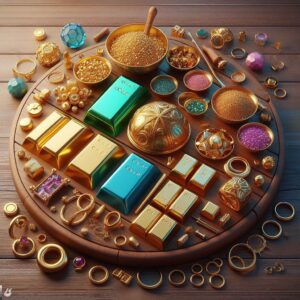Gold

Legend
“Some say it’s blood of the Vornir, spilled into our World, others stick to it merely being ‘that type of Mana‘.”
History

It was first discovered back in the Dark Ages, when Boriac gatherers came from the Astral and searched all over The Void. There, they encountered several mana leaks that had produced gold. They brought it back to the Vornir, but also discussed the findings with Thursar, who themselves began searching and hoarding this most precious of Metals.
Skjald Valgrif
First Age
In the creation of our world, the Divine Races generally organised things as grouped as possible, so some places have plenty of gold ores while others have none. With Thursar harvesting, as good as all surface deposits were hoarded, and as several Indigenous Tribes also gathered gold for various purposes. The possibility of finding gold laying around dimminished, and individuals began to examine water sources, search through top soil, or mine deep into the world.
Through time, it has been used as jewellery, coins, inlays, and ingredients.
Skjald Sejrik
Organisation
Gold often occurs as nuggets or grains in rocks, veins, and alluvial deposits. It occurs with silver, alloyed with other metals like copper and palladium, and mineral inclusions such as within pyrite. A relatively rare element, gold is a precious metal and the most malleable of all metals. It can be drawn into a very thin wire and stretched considerably before it breaks.
Skjald Sigurd
Whereas most metals are grey or silvery white, pure gold is slightly reddish-yellow. Many Mana Manipulator, Jeweller, and Alchemist have worked with gold to create blends that match the Magic Wheel. Aura Colours.
Cyan: When gold is mixed in a ratio of 72,5% gold, 25% Iron, and 2,5% Gallium, it produces a gold that is cyan. It’s almost as brittle as blue gold alloys, but it must also be said that Humans should avoid having gallium in contact with their skin.
Green: When gold is mixed in a ratio of 75% gold, 15% silver Silver, 6% copper Copper, and 4% cadmium Cadmium, it produces a dark-greenish gold alloy. Cadmium is highly toxic to humans and should thus not be used in jewellery worn on the skin.
Yellow: When gold is mixed in a ratio of 75% gold, 12.5% copper, and 12.5% silver, it produces 18ct yellowish gold.
Orange: When gold is mixed in a ratio of 75% gold and 25% copper, it produces orange gold.
Red: When gold is mixed in a ratio of 75% gold and 25% copper, it produces a gold that is reddish. For the collectors, it’s called ‘blood gold’. As soon as silver or the like is added to lighten the colour, it falls into ‘Rose Gold’.
Pink: When gold is mixed in a ratio of 75% gold, 20% copper, and 5% silver, it produces pinkish gold. For collectors, it’s also called ‘Rose Gold’, and can consist of differing quantities of gold, copper, and silver to desaturate and balance the severity of the colour.
Violet: When gold is mixed in a ratio of 79% gold and 21% Aluminium, it produces a gold that is violet.
Blue: When gold is mixed in a ratio of 75% gold, 24.4% iron, and 0.6% Nickel, it produces a gold that is blue. But it must be mixed between 450 and 600 °C, and it must be said that it is the most brittle of the gold alloys.
White gold is created by adding Palladium. and Nickel.
Black gold:. When gold is mixed in a ratio of 75% gold with 25% cobalt, it produces a blackish gold.
Skjald El Mary
Special
If you find ore… or nuggets galore… keep it hidden… or see it ridden…
Skjald Kazumix
Last Updated on 2024-02-10 by IoM-Christian
